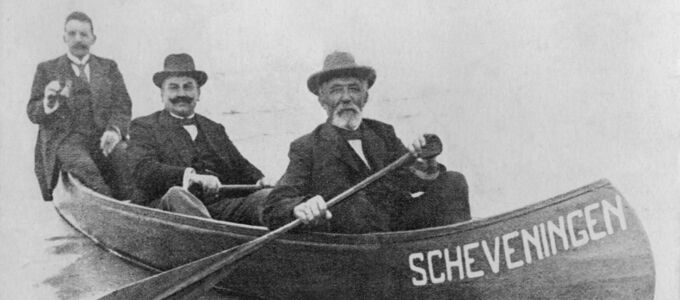
The “father of unity” was followed by the organiser and protector of New Apostolic unity, namely Chief Apostle Hermann Niehaus. On 23 August 2022, we mark the 90th anniversary of his passing. This is the story of how the erstwhile farmer cultivated the church field.
In certain respects he was even the first Chief Apostle of the New Apostolic congregations. Although his predecessor Friedrich Krebs—whose contemporaries were fond of calling him the “father of unity“—is regarded as the actual founder of this office, the official designation of this ministry is only formally recorded after his death, specifically in the statutes of 1906, which already bear the handwriting of his successor.
Taking language instruction as an Evangelist
Hermann Christoph Niehaus was born on 28 July 1848 in Steinhagen, Germany, where he grew up under modest circumstances. Already in his early years he had to help along on his parents’ farm, and with diligence and perseverance, he developed the rural property into a handsome estate.
At first he had little to do with the Christian beliefs and practices of his parents, but he later became an enthusiastic listener of Friedrich Wilhelm Menkhoff, who came to Westphalia as an Evangelist from the New Apostolic congregations. These experiences led Hermann Niehaus to receive the sacrament of Holy Sealing together with his parents when Apostle Friedrich Wilhelm Schwarz came to Bielefeld for the first time on 2 August 1868.
A week later, he was ordained a Deacon—and then an Evangelist a year after that. In order to be able to preach properly, he took some remedial lessons in High German. This was because he had only learned to speak the Low German dialect in school. His ecclesiastical journey led him into various other ministries, and culminated in his ordination to the Apostle ministry on 21 June 1896. In 1898 Friedrich Krebs designated him as his successor to lead the Church. The “father of unity” passed away seven years later.
Bringing harmony to the foundations
When Hermann Niehaus assumed the office of Chief Apostle, he set to work with great energy and zeal:
- by 1905 he had already travelled through all the Apostle districts of Germany, restructured the working areas, and ordained three other Apostles.
- in 1907 the local church registers began to refer to the Church by its new designation, namely the “New Apostolic Congregation”.
- the publication of the “Sonntagsblatt” [Sunday paper], which transitioned into the “Neuapostolische Rundschau” [New Apostolic Review] in 1909, also began in 1907. In 1927 the establishment of an in-house printshop was commissioned, which eventually developed into the Church publishers.
- 1908 marked the publication of the Church’s first teaching material for children in the form of the “Hülfsbuch” [Aid book]. This was followed in 1916 by the “Lehrbuch für den Religionsunterricht” [Religious Instruction textbook], the precursor to “Questions and Answers”.
- from 1909 to 1913 the Church published several defences against polemic literature deriving mainly from the Protestant domain.
- starting in 1914, soldiers in the First World War were sent Holy Communion in the form of wafers sprinkled with wine. This developed into the combo-wafer which came into binding general use in 1919.
- in 1921 the New Apostolic Church acquired the status of a corporation under public law in Baden, and in 1925 in Hamburg.
Apostles decide to go their own ways
The centralisation of the organisation and doctrine of the Church did not remain without its consequences, however: Apostle Heinrich Friedrich Niemeyer (Australia) and his foster son Carl Georg Klibbe (South Africa) decided to separate from the unity of the Apostles in the early 1910s. This led to the development of the “Apostolic Church of Queensland” in Australia and the “Old Apostolic Church” in the Cape region.
Meanwhile, at the beginning of the 1920s, two established leaders came to be at odds with one another: on the one hand, Apostle Carl August Brückner (Dresden) advocated for progress and developed increasingly unusual ideas. On the other hand, Chief Apostle Niehaus strove for calm and stability following the turbulent times of the First World War. So it was that the “Reformed Apostolic Congregational Union” also separated.
A track record of unity
But none of this was able to get in the way of progress: In 1922, the first central organisational unit—in the form of an association—was founded in the form of the “College of Apostles”, a forerunner of today’s New Apostolic Church International (NACI). When Hermann Niehaus began his activity, he assumed leadership over 517 congregations. By the end of his ministerial work, the Church numbered 1,771 congregations around the world.
After suffering from the consequences of an accident at home, Chief Apostle Niehaus retired on 20 September 1930, and died on 23 August 1932. His funeral service was based on a Bible text from Hebrews 13: 7: “Remember those who rule over you, who have spoken the word of God to you, whose faith follow, considering the outcome of their conduct.”




